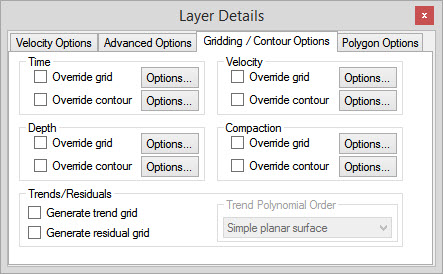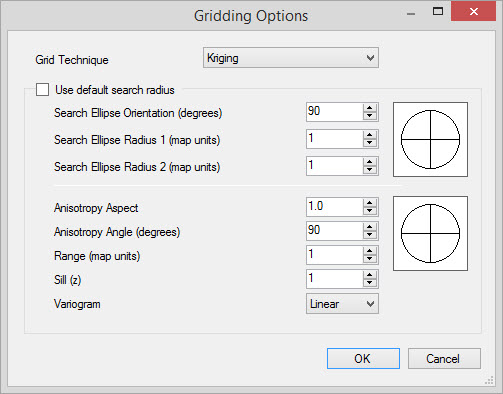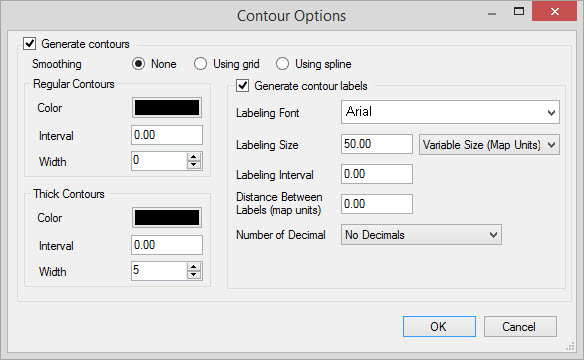Time/Depth Velocity Modeling: Gridding/Contour Options
The Gridding/Contour Options tab in the Layer Details dialog box is used to override the default grid and contour parameters, and create trend and residual grids for the layer currently selected in the Layers dialog box.

Grid and Contour Overrides
Default grid and contour parameters are set in the Properties dialog. To override the default settings for the time, velocity, compaction, or depth grids, place a check mark in the Override check box and click  . This will open the Grid Options or Contour Options
dialog boxes. Overrides are only applied to the specified grid for the
selected layer; when no overrides are set, the default parameters are
used.
. This will open the Grid Options or Contour Options
dialog boxes. Overrides are only applied to the specified grid for the
selected layer; when no overrides are set, the default parameters are
used.
Grid Options
This dialog box contains the same options found on the Gridding Options tab in the Properties dialog box.

Contour Options
This dialog box contains the same options found on the Contour Options tab in the Properties dialog box.

Trend and Residual Grids
Create trend and residual grids for the layer currently selected in the Layers dialog box.
Generate Trend Grid:Creates a trend surface and attach it to the project. The trend surface is calculated using a polynomial regression algorithm to create a smooth surface that approximates the seed points. The higher the order of the polynomial used, the more closely the trend surface will match the seed points.
Generate Residual Grid: Create a residual surface and attach it to the project. This is the difference between the trend surface and the gridded surface. The residual surface can show anomalies between the gridded surface and the trend surface.
Trend Polynomial Order:Select the
order of the polynomial that will be used in generating the trend
surface. The higher the order, the more closely the trend surface will
match the seed points. Also, the higher the order, the longer it will
take to calculate the trend surface.
- Simple Planar Surface: Creates the residual surface using the function z(x,y) = A + Bx + Cy
- Bi-linear Spline: Creates the residual surface using the function z(x,y) = A + Bx + Cy + Dxy
- Quadratic Surface: Creates the residual surface using the function z(x,y) = A + Bx + Cy + Dx2 + Exy + Fy2
- Cubic Surface: Creates the residual surface using the function z(x,y) = A + Bx + Cy + Dx2 + Exy + Fy2 + Gx3 + Hx2y + Ixy2 + Jy3
- 4th Order: Creates the residual surface using the function z(x,y) = A + Bx + Cy + Dx2 + Exy + Fy2 + Gx3 + Hx2y + Ixy2 + Jy3 + Kx4 + Lx3y + Mx2y2 + Nxy3 + Oy4
- 5th Order: Similar to the above 4th order
- 6th Order: Similar to the above 4th order
- 7th Order: Similar to the
above 4th order
Also See
— MORE INFORMATION

|
Copyright © 2020 | SeisWare International Inc. | All rights reserved |